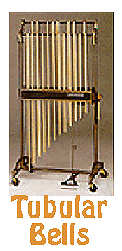Tubular Bells
Tubular Bells
Contents :
History
The bell is know in all cultures around the globe. Its origin has not yet been determined fully, but it is known that they appeared in many ancient cultures.
It is known that the first uses of the bell was not musical. Bells were originally used for rituals and magic. They served as amulets, as a protection from evil spirits. They were placed at doors to protect the home and sounded at places of worship to purify them, not call the worshipers.
Bells have been made in many different forms. A bee-hive shaped bronze bell of Assyria is dated back to the 8th century B.C. Wooden bells of a rectangular form were found in Peru. Asian bells lacking clappers were originally square.
The ancient art of casting bells was rediscovered in the 8th or 9th century A.D. Bell making became primarily a church art. Bells were made longer for a deeper sound and smaller and thicker for a higher sound.
The shallow bowl-shaped bell of medieval Europe has existed since at least the 14th century. It is struck from the outside by a hammer. It is considered to be of Asiatic origin. These types of bells are cast from metal.
Improvements came in the form of better casting methods, formulas for raising and lowering the pitch, and mechanized weight-driven clocks for sounding bells at the hour.
The bells became so unwieldy in the orchestra that they were replaced with the developed tubular bells in the 1880's because they so closely imitate church bells.
Top
Description
Tubular bells are sets of tuned metal tubes made of brass. These tubes are of different lengths and have a diameter of 1.5 inches. They are suspended vertically from a large frame, usually made of metal. The tubes are arranged similar to a piano keyboard. They are provided with dampers operated either by hand or by a petal connected to the damping bar.

Top
Sound Production
Sound is produced by striking one of the tubes with one or two rawhide or wooden mallets. This causes the tube to vibrate. The tubes are tuned chromatically, starting with c above middle c and extending 1.5 octaves. The pitch is determined by the length of the tube being struck. The longer the tube, the lower the pitch.
